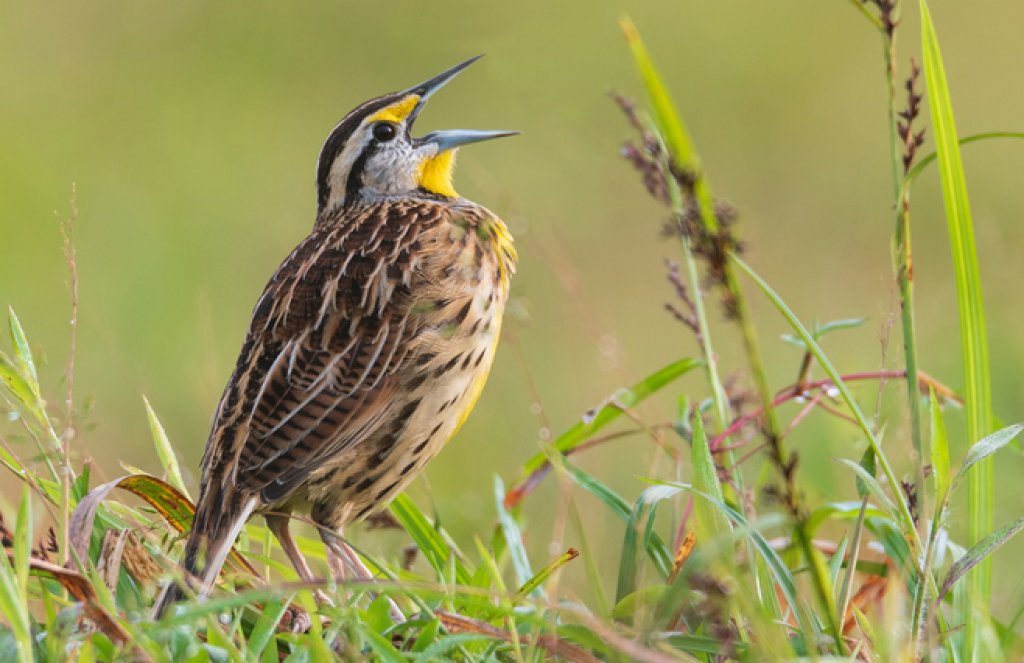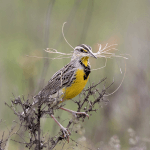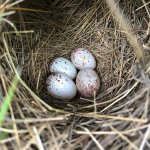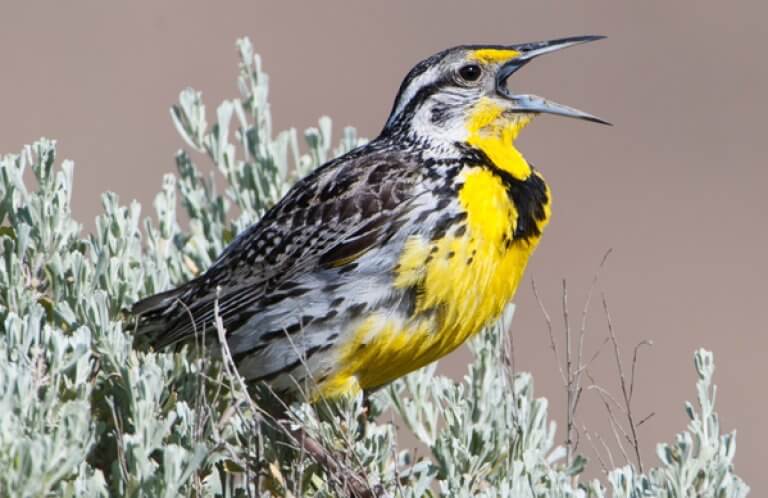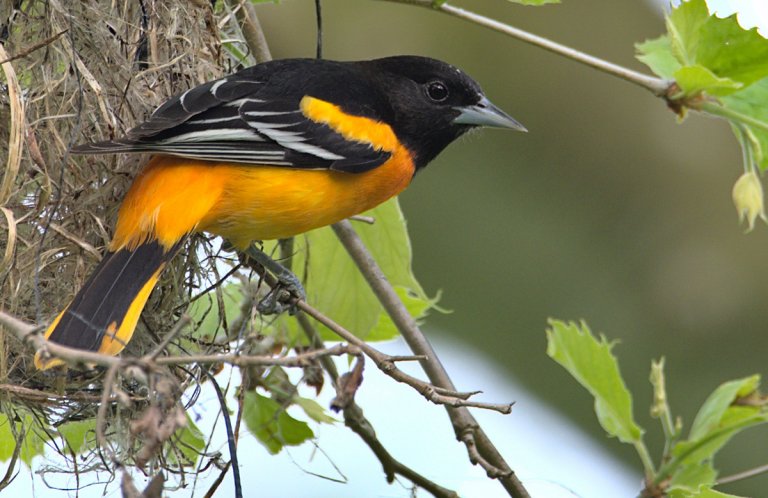About the Eastern Meadowlark
Often hunkered down in the grasses, the Eastern Meadowlark may surprise a casual observer: This stout-bodied bird sports a cryptic, streaky brown back, but when facing you, you see its shocking yellow breast, emblazoned with a bold, black “V.” Spring and early summer are best for spotting these birds, when males perch in isolated field trees and shrubs or on fence posts, incessantly belting out their distinctive song.
Meadowlarks belong to the family Icteridae, which includes blackbirds, cowbirds, grackles, and orioles, including Baltimore and Audubon's Orioles.
The Eastern Meadowlark is one of two meadowlark species found in the United States and Canada.
A Species or Not a Species? …That Is a Question.
There are at least 15 Eastern Meadowlark subspecies, three of which are found in the United States. One of these extends into Canada.
In 2022, the American Ornithological Society split the Eastern Meadowlark into Eastern and Chihuahuan Meadowlarks. The newly recognized species, the Chihuahuan Meadowlark (Sturnella lilianae), includes the pale-plumaged Lilian's subspecies from Arizona, New Mexico, and northern Mexico, which was once believed a possible species in its own right. Another former subspecies from western Mexico (Sturnella l. auropectoralis) is now included in the larger Chihuahuan species group.
The Western Meadowlark is very similar to the Eastern, but has a different song and call. The two species' ranges broadly overlap in the central and southwestern United States, where visual identification takes some care. In breeding plumage, the Eastern Meadowlark has a whitish moustache, while the Western's is yellow. In the drab nonbreeding plumage, Eastern Meadowlarks have striking blackish head stripes, unlike the Western's subtler brown ones. In flight, the Eastern Meadowlark usually flashes more white in the outer tail feathers than its western cousins, though this field mark takes practice to learn. Despite the range overlap, the two species rarely interbreed.
Songs and Sounds
The Eastern Meadowlark's distinctive song sounds like the bird is proclaiming “Spring-of-the YEEAAR;” in Mexico its vocalization is interpreted as “Tortilla Con Chile.” Listen here:
It can also be detected by its harsh, rattling call:
Breeding and Feeding
A Grassy Hideaway
In breeding season, the female Eastern Meadowlark crafts a domed nest of grasses, placed on the ground under thick cover. She weaves the grass stems in and out of surrounding vegetation so that there is a secure overhang, while one side remains open as an entrance. In this domed refuge, she incubates three to five spotted eggs, which hatch in approximately two weeks. Both parents feed their nestlings. Although the young leave the nest after about 12 days, the parents tend them for at least two more weeks. If all goes well, a meadowlark pair raises two broods each year.
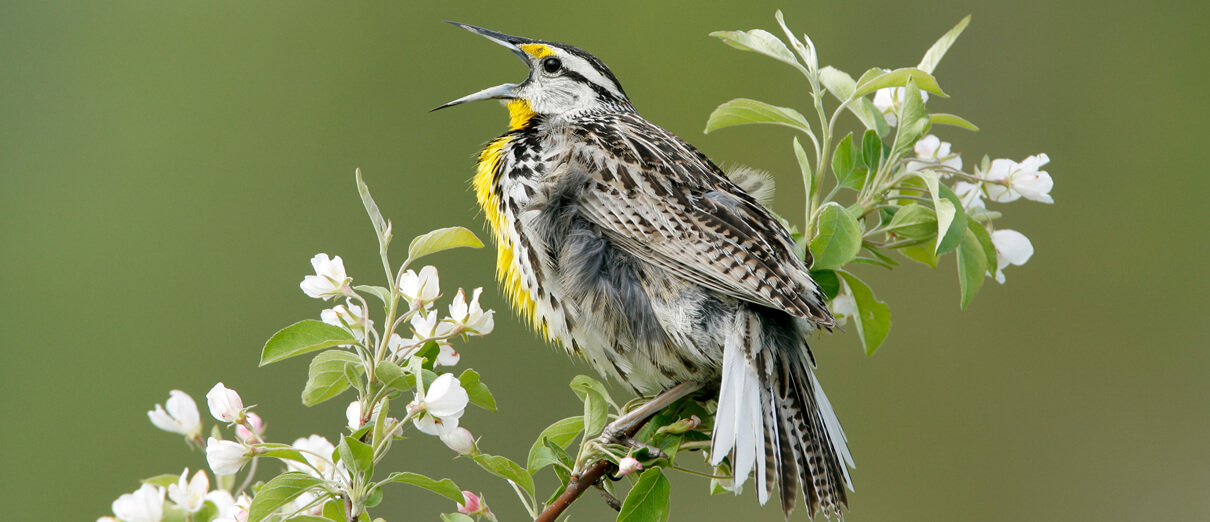
Fielding a Seasonal Menu
In warm weather, Eastern Meadowlarks eat invertebrates they find lurking in the grasses, including grasshoppers, crickets, katydids, beetles, grubs, caterpillars, ants, and spiders. The diet shifts to plant matter fall through early spring, when the birds dine on a wide variety of seeds and left-over grain found in harvested farm fields.
Region and Range

An estimated 65 percent of the Eastern Meadowlark population occurs in the United States and Canada, where populations are believed to have declined by 77 percent between 1970 and 2014.
Despite many regional declines, the Eastern Meadowlark has a wide distribution, both in the United States and southward. The Western Meadowlark ranges no farther than central Mexico, but the Eastern Meadowlark inhabits much of that country, as well as Central America, Cuba, and northern South America, from Colombia east to far-northern Brazil. Only a few other songbirds have as wide a distribution in the Americas.
Conservation
Fading with the Grasses
The Eastern Meadowlark's song was once one of the most familiar sounds in the countryside of the East and Midwest. But many large-scale farming enterprises no longer support the type of varied grassy habitats these birds need, while many northeastern meadow habitats have reforested.
Even farms where meadowlarks find suitable cover and food often prove inhospitable: For example, many hay fields are harvested during nesting season, killing young birds or destroying eggs. Overgrazing of pastures and pesticides also threaten meadowlarks.

Help support ABC's conservation mission!
Most meadowlark habitat falls under private ownership. Farmers and ranchers who practice conservation methods along with their daily business can have a huge impact on this bird's future. Fallow fields, for example, not only rest the soil – they provide ideal habitat for the Eastern Meadowlark as well as the Grasshopper Sparrow, Henslow's Sparrow, Dickcissel, and many other grassland birds.
The Eastern Meadowlark is found in ABC BirdScapes in the central and eastern United States. BirdScapes are landscape-scale areas where ABC and its partners work to combine smart land use with effective bird conservation that provides habitat to help sustain or recover targeted migratory bird species or populations.
ABC is advocating for measures to be included in the 2023 Farm Bill that have the best chance of keeping U.S. grassland species like the Eastern Meadowlark from disappearing. In particular, the recommendations included in ABC's “Bird Saver" platform would help the Farm Bill channel funds designated for conservation to the programs that would make the biggest difference for grasslands.
Get Involved
Policies enacted by the U.S. Congress and federal agencies, such as the U.S. Fish and Wildlife Service, have a huge impact on migratory birds. You can help shape these rules for the better by telling lawmakers to prioritize birds, bird habitat, and bird-friendly measures. To get started, visit ABC's Action Center.
Living a bird-friendly life can have an immediate impact on migratory birds in the United States. Doing so can be as easy as adding native plants to your garden, avoiding pesticides, and keeping cats indoors. To learn more, visit our Bird-Friendly Life page.
American Bird Conservancy and our Migratory Bird Joint Venture partners have improved conservation management on more than 8.5 million acres of U.S. bird habitat — an area larger than the state of Maryland — over the last ten years. That's not all: With the help of international partners, we've established a network of more than 100 areas of priority bird habitat across the Americas, helping to ensure that birds' needs are met during all stages of their lifecycles. These are monumental undertakings, requiring the support of many, and you can help by making a gift today.





































